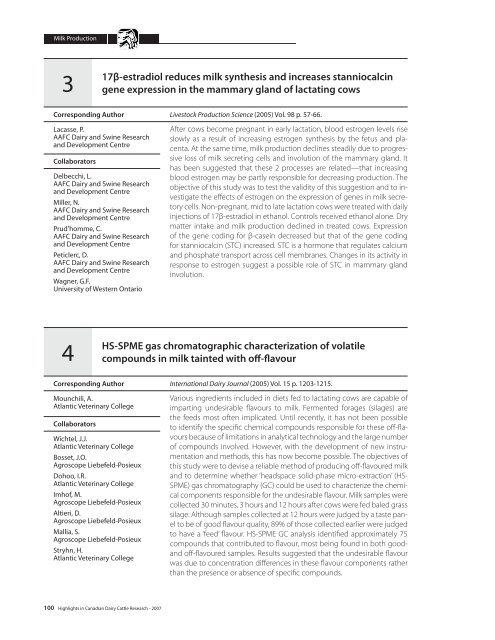A52-75-2007E.pdf - AgroMedia International Inc
A52-75-2007E.pdf - AgroMedia International Inc
A52-75-2007E.pdf - AgroMedia International Inc
You also want an ePaper? Increase the reach of your titles
YUMPU automatically turns print PDFs into web optimized ePapers that Google loves.
Milk Production317β-estradiol reduces milk synthesis and increases stanniocalcingene expression in the mammary gland of lactating cowsCorresponding AuthorLacasse, P.AAFC Dairy and Swine Researchand Development CentreCollaboratorsDelbecchi, L.AAFC Dairy and Swine Researchand Development CentreMiller, N.AAFC Dairy and Swine Researchand Development CentrePrud’homme, C.AAFC Dairy and Swine Researchand Development CentrePeticlerc, D.AAFC Dairy and Swine Researchand Development CentreWagner, G.F.University of Western OntarioLivestock Production Science (2005) Vol. 98 p. 57-66.After cows become pregnant in early lactation, blood estrogen levels riseslowly as a result of increasing estrogen synthesis by the fetus and placenta.At the same time, milk production declines steadily due to progressiveloss of milk secreting cells and involution of the mammary gland. Ithas been suggested that these 2 processes are related—that increasingblood estrogen may be partly responsible for decreasing production. Theobjective of this study was to test the validity of this suggestion and to investigatethe effects of estrogen on the expression of genes in milk secretorycells. Non-pregnant, mid to late lactation cows were treated with dailyinjections of 17β-estradiol in ethanol. Controls received ethanol alone. Drymatter intake and milk production declined in treated cows. Expressionof the gene coding for β-casein decreased but that of the gene codingfor stanniocalcin (STC) increased. STC is a hormone that regulates calciumand phosphate transport across cell membranes. Changes in its activity inresponse to estrogen suggest a possible role of STC in mammary glandinvolution.4HS-SPME gas chromatographic characterization of volatilecompounds in milk tainted with off-flavourCorresponding AuthorMounchili, A.Atlantic Veterinary CollegeCollaboratorsWichtel, J.J.Atlantic Veterinary CollegeBosset, J.O.Agroscope Liebefeld-PosieuxDohoo, I.R.Atlantic Veterinary CollegeImhof, M.Agroscope Liebefeld-PosieuxAltieri, D.Agroscope Liebefeld-PosieuxMallia, S.Agroscope Liebefeld-PosieuxStryhn, H.Atlantic Veterinary College<strong>International</strong> Dairy Journal (2005) Vol. 15 p. 1203-1215.Various ingredients included in diets fed to lactating cows are capable ofimparting undesirable flavours to milk. Fermented forages (silages) arethe feeds most often implicated. Until recently, it has not been possibleto identify the specific chemical compounds responsible for these off-flavoursbecause of limitations in analytical technology and the large numberof compounds involved. However, with the development of new instrumentationand methods, this has now become possible. The objectives ofthis study were to devise a reliable method of producing off-flavoured milkand to determine whether ‘headspace solid-phase micro-extraction’ (HS-SPME) gas chromatography (GC) could be used to characterize the chemicalcomponents responsible for the undesirable flavour. Milk samples werecollected 30 minutes, 3 hours and 12 hours after cows were fed baled grasssilage. Although samples collected at 12 hours were judged by a taste panelto be of good flavour quality, 89% of those collected earlier were judgedto have a ‘feed’ flavour. HS-SPME GC analysis identified approximately <strong>75</strong>compounds that contributed to flavour, most being found in both goodandoff-flavoured samples. Results suggested that the undesirable flavourwas due to concentration differences in these flavour components ratherthan the presence or absence of specific compounds.100 Highlights in Canadian Dairy Cattle Research - 2007





